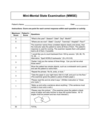Psych Flashcards
(231 cards)
What is Deprivation of Liberty Safeguards(DoLS)?
Procedure prescribed in law when it is necessary to deprive of their liberty a resident or patient who lacks capacity to consent to their care and treatment in order to keep them safe from harm.
What are the 3 core syx of depression
- Low mood
- Anhedonia
- Anergia
Biological manifestastions of depression
- Fatigue/sleep distrubance
- Appetite/weight change
- Low libido
Cognitive features depression
- Memory impairment
- Beck’s triad
- Hoplessness
- Worthlessness
- Helplessness
Depression diagnosis criteria timeframe
Syx lasting at least 2 weeks
Depression levels of severity
Mild: 2 or 3 core syx + 2 others; can continue w most dialy activities
Moderate: 2 or 3 core syx + 3-4 others; difficulty with social acitivities and day to day functioning
Severe: 3 core syx + 4 or more others; major impact on daily function
Things to consider when diagnosing depression
- Organic causes
- FBC
- TFT
- Bipolar disorder
- Previous mood elevation - (hypo)mania
High risk features of completing suicide attempt
- Careful planning
- Acts in anticipation
- Precautions to prevent discovery
- Suicide note
- Violent method
Depression Ix

Depression mx
Bio
- Antidepressants
- SSRI - sertraline, fluoxetine, citalopram, etc.
- SNRI - venlafaxine
- Augmentation therapy
- Diff class antidepr // add lithium
- ECT
Psycho
- Self help
- CBT
- Interpersonal therapy
Social
- Finance
- Relationships
- Occupation
–
Mild- moderate
- Low intensity psychological intervention
- Guided self-help
- Computerised CBT
- Structured group physical activity programme
- Group CBT
- +/- medication
- 2 week follow up
Moderate - severe
- High intensity psychological intervention
- Individualised CBT
- Interpersonal therapy
- Medication

Classes of antidepressants and examples of each
Selective serotoni receptor inhibitors (SSRIs)
- Sertraline
- Fluoxetine
- Citalopram
- Escitalopram
Serotonin and noradrenaline receptor inhibitors (SNRIs)
- Venlafaxine
- Deloxetine
Tricyclic anti-depressants (TCAs)
- Amitriptyline
- Notriptyline
Monoamine oxidase inhibitors (MAOis)
- Phenelzine
Noradrenergic and specific serotonergic antidepressants (NaSSA)
- Mirtazapine
Reversible inhibitors of monoamine oxidase type A (RIMAs)
- Moclobemide
How long should pts continue antidepressants post-recovery for optimum prognosis?
6 months
SSRI side effects
- GI syx
- GI bleeding (+PPI)
-
Hyponatraemia
- confusion, dizziness and weakness
How long does it take to stop an SSRI?
Withdraw gradually over 4 weeks
*Except fluoxetine due to its longer half life
SSRI discontinuation syndrome
- Anxiety
- GI symptoms
- Electric shock sensations
- Dizziness
SSRIs and pregnancy
Avoid unless benefits outweigh risks
- 1st trimester - small increased risk of congenital heart defects
- 3rd trimester - can result in persistent pulmonary hypertension of the newborn
Indications for Sertraline
Unstable angina or recent MI
How to swap from Fluoxetine to different SSRI?
Stop fluoxetine then 1 week wash out period (due to long half life) then start gradually
Citalopram and Escitalopram SEs
ventricular arrhythmias including torsade de pointes
Serotonin syndrome
- confusion
- agitation
- muscle twitching
- sweating
- shivering
- diarrhoea
SNRI SEs
- Hypertension
TCA side effects
- Overflow urinary incontinence
- Prolonged QT on ECG
MAO-I Precaution
Avoid cheese (tyramine) –> hypertensive crisis
What (non-psych) drug can cause low mood?
Beta blockers




















